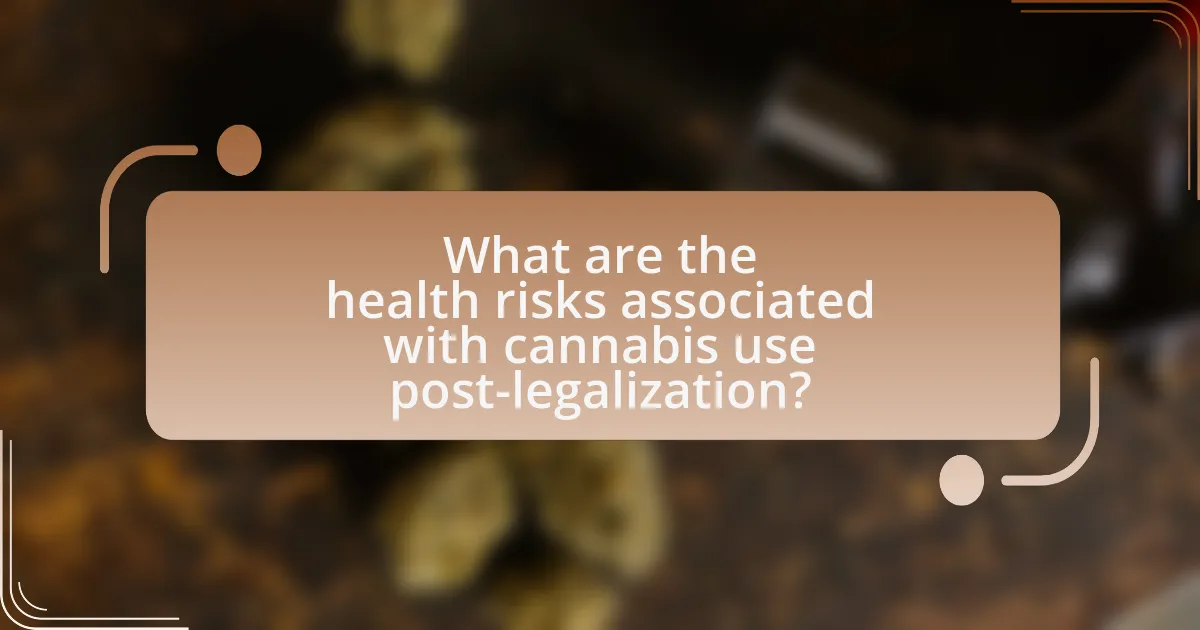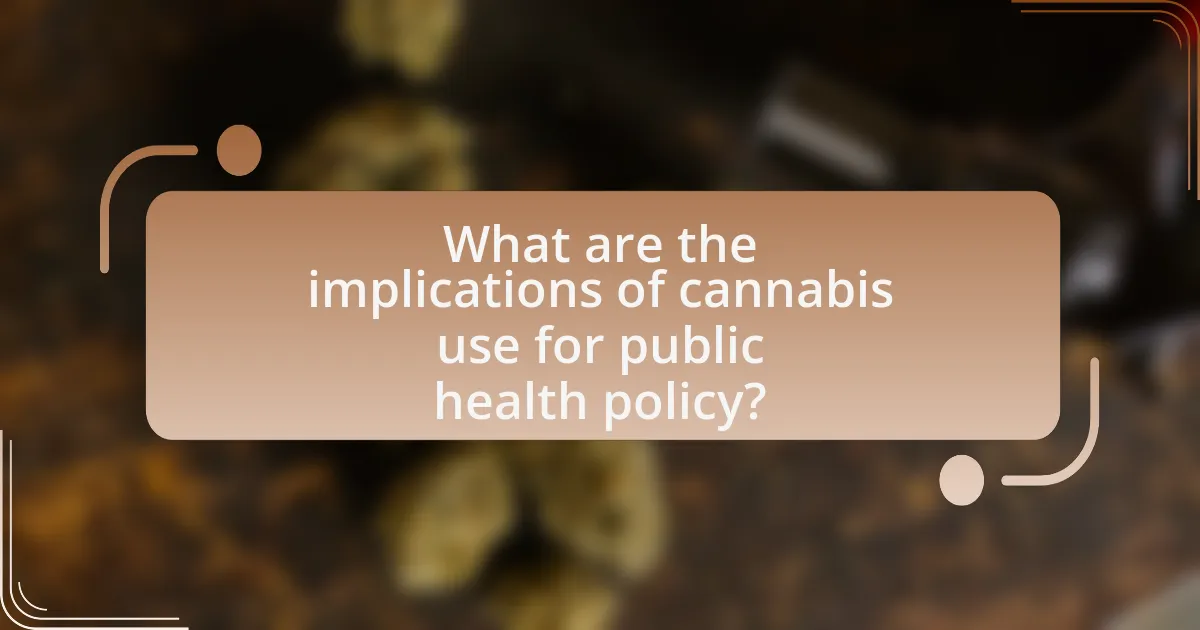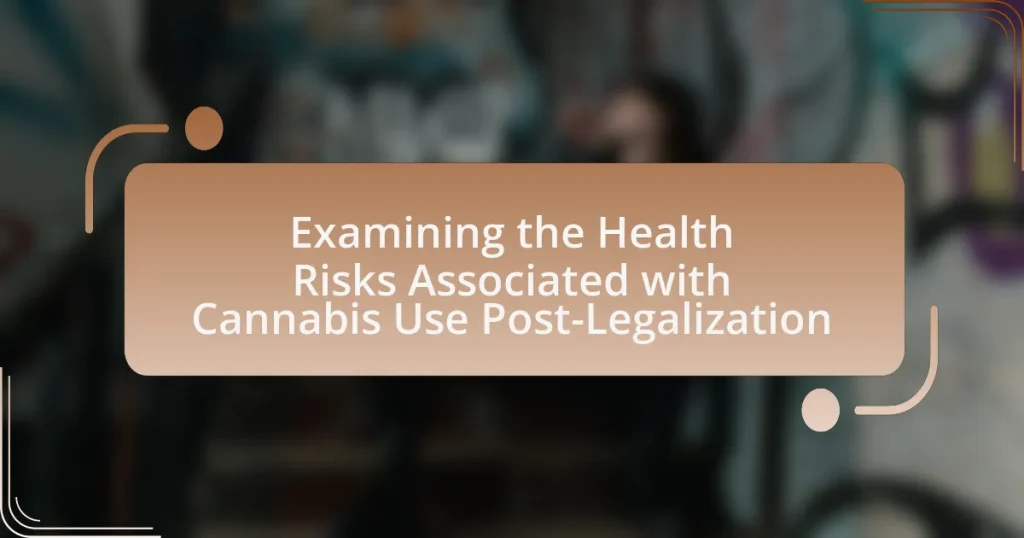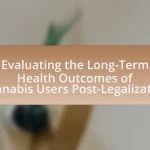The article examines the health risks associated with cannabis use following its legalization, highlighting concerns related to respiratory issues, mental health disorders, and cognitive impairments. It discusses the impact of cannabis on physical health, including both short-term effects like increased heart rate and long-term consequences such as respiratory problems and dependency. The article also addresses how demographic factors, such as age and gender, influence these health risks, and outlines the regulatory frameworks governing cannabis use across different regions. Additionally, it explores the implications for public health policy and healthcare systems, emphasizing the need for education and harm reduction strategies to mitigate potential health risks.

What are the health risks associated with cannabis use post-legalization?
Cannabis use post-legalization is associated with several health risks, including respiratory issues, mental health disorders, and impaired cognitive function. Research indicates that smoking cannabis can lead to chronic bronchitis and other respiratory problems due to the inhalation of harmful substances. Additionally, studies have shown a correlation between cannabis use and increased risks of anxiety, depression, and psychosis, particularly in individuals with a predisposition to mental health issues. Cognitive impairments, such as decreased attention and memory deficits, have also been documented, especially in adolescents and young adults whose brains are still developing. These health risks highlight the importance of understanding the implications of cannabis use in a legalized context.
How does cannabis affect physical health?
Cannabis affects physical health by influencing various bodily systems, primarily through its active compounds, cannabinoids. Research indicates that cannabis use can lead to both positive and negative health outcomes. For instance, cannabinoids like THC can alleviate chronic pain and reduce inflammation, which is beneficial for conditions such as arthritis. Conversely, cannabis can impair lung function when smoked, leading to respiratory issues, as evidenced by a study published in the Journal of the American Medical Association, which found that regular cannabis smoking is associated with increased respiratory symptoms. Additionally, cannabis use has been linked to cardiovascular risks, including increased heart rate and blood pressure, particularly in inexperienced users. Overall, the impact of cannabis on physical health is multifaceted, with both therapeutic benefits and potential health risks.
What are the short-term physical health effects of cannabis use?
Short-term physical health effects of cannabis use include increased heart rate, dry mouth, and bloodshot eyes. Research indicates that cannabis can elevate heart rate by 20 to 50 beats per minute shortly after consumption, which may pose risks for individuals with pre-existing heart conditions. Additionally, users often experience dry mouth due to the compound THC affecting salivary glands, and bloodshot eyes result from the dilation of blood vessels in the eyes, a common physiological response to cannabis use. These effects are well-documented in studies examining the acute physiological responses to cannabis consumption.
What are the long-term physical health effects of cannabis use?
Long-term cannabis use can lead to respiratory issues, cardiovascular problems, and potential dependency. Chronic inhalation of cannabis smoke is associated with bronchitis and other lung-related conditions due to the presence of harmful tar and chemicals. Studies indicate that regular cannabis users may experience increased heart rate and blood pressure, which can elevate the risk of heart disease. Additionally, prolonged use can result in cannabis use disorder, characterized by cravings and withdrawal symptoms, affecting overall physical health. Research published in the Journal of the American Heart Association highlights these cardiovascular risks, emphasizing the need for awareness regarding the long-term effects of cannabis consumption.
How does cannabis impact mental health?
Cannabis can negatively impact mental health by increasing the risk of anxiety, depression, and psychosis. Research indicates that regular cannabis use, particularly high-THC strains, is associated with a higher likelihood of developing these mental health disorders. A study published in the journal “Psychological Medicine” found that individuals who use cannabis frequently are more likely to experience symptoms of psychosis, with a dose-response relationship observed, meaning that higher usage correlates with greater risk. Additionally, the National Institute on Drug Abuse reports that cannabis use can exacerbate pre-existing mental health conditions and may lead to dependency, further complicating mental health outcomes.
What are the immediate mental health effects of cannabis use?
The immediate mental health effects of cannabis use include altered perception, anxiety, and impaired memory. Cannabis primarily affects the brain’s endocannabinoid system, leading to changes in mood and cognitive function. Research indicates that THC, the psychoactive component of cannabis, can induce feelings of euphoria but may also trigger anxiety or paranoia in some users. A study published in the journal “Psychological Medicine” found that acute cannabis use can lead to increased anxiety levels, particularly in individuals predisposed to anxiety disorders. Additionally, cannabis can impair short-term memory and attention, as evidenced by findings from the National Institute on Drug Abuse, which highlight the cognitive deficits associated with immediate cannabis consumption.
What are the potential long-term mental health consequences of cannabis use?
Long-term cannabis use can lead to several mental health consequences, including an increased risk of anxiety disorders, depression, and psychosis. Research indicates that individuals who use cannabis frequently are more likely to experience these mental health issues, particularly if they begin using at a young age. A study published in the journal “Psychological Medicine” found that regular cannabis users had a 2.5 times higher risk of developing psychotic disorders compared to non-users. Additionally, the National Institute on Drug Abuse highlights that cannabis use can exacerbate existing mental health conditions and may lead to cognitive impairments, affecting memory and learning.
What demographic factors influence health risks associated with cannabis use?
Demographic factors such as age, gender, socioeconomic status, and ethnicity significantly influence health risks associated with cannabis use. Research indicates that younger individuals, particularly those aged 18 to 25, are at a higher risk for developing cannabis use disorders and experiencing negative mental health outcomes, including anxiety and depression. Gender differences also play a role; studies show that males are more likely to use cannabis and may experience more severe health consequences compared to females. Socioeconomic status affects access to healthcare and education about cannabis, which can lead to varying health outcomes. Additionally, ethnic disparities exist, with certain groups reporting higher rates of cannabis use and associated health risks, influenced by cultural attitudes and legal status in different regions. These factors collectively shape the landscape of health risks linked to cannabis consumption.
How do age and gender affect the health risks of cannabis use?
Age and gender significantly influence the health risks associated with cannabis use. Younger individuals, particularly adolescents and young adults, are at a higher risk for developing cannabis use disorders and experiencing negative cognitive effects due to ongoing brain development. Research indicates that early cannabis use can lead to long-term impairments in memory, attention, and learning (Meier et al., 2012, Proceedings of the National Academy of Sciences).
Gender differences also play a role; studies show that women may experience more severe psychological effects from cannabis use, such as anxiety and depression, compared to men. Additionally, hormonal fluctuations in women can affect how cannabis is metabolized, potentially increasing the risk of adverse effects during certain phases of the menstrual cycle (Baker et al., 2019, Journal of Psychopharmacology).
Overall, both age and gender are critical factors in assessing the health risks of cannabis use, with younger users and women facing distinct vulnerabilities.
What role does frequency of use play in health risks?
Frequency of use significantly influences health risks associated with cannabis consumption. Higher frequency of use is correlated with increased likelihood of developing mental health issues, such as anxiety and depression, as well as physical health problems, including respiratory issues and dependence. Research indicates that daily cannabis users are more likely to experience adverse effects compared to occasional users, with studies showing that daily use can lead to a 2-3 times higher risk of developing cannabis use disorder (CUD) and other mental health disorders (American Psychiatric Association, 2013). Additionally, frequent use can exacerbate cognitive impairments and negatively impact academic and occupational performance.

What are the regulatory frameworks surrounding cannabis use?
The regulatory frameworks surrounding cannabis use vary significantly by country and region, primarily focusing on legality, distribution, and consumption guidelines. In the United States, for instance, cannabis is legal for recreational use in 23 states and for medical use in 36 states, with regulations established at both state and federal levels. The federal government classifies cannabis as a Schedule I substance under the Controlled Substances Act, which complicates its legal status despite state-level legalization. In Canada, the Cannabis Act of 2018 legalized recreational cannabis nationwide, establishing a framework for production, distribution, and sale, while also imposing strict regulations on advertising and consumption. Similarly, countries like Uruguay have implemented comprehensive legal frameworks that regulate the cultivation, sale, and consumption of cannabis, emphasizing public health and safety. These frameworks are designed to address health risks associated with cannabis use, ensuring that regulations evolve alongside emerging research and societal attitudes.
How do different regions regulate cannabis use?
Different regions regulate cannabis use through a variety of legal frameworks that dictate its legality, distribution, and consumption. For instance, in the United States, states like California and Colorado have legalized recreational cannabis, implementing regulations that govern sales, age restrictions, and taxation, while other states maintain strict prohibitions. In Canada, the Cannabis Act of 2018 established a nationwide legal framework for the production, distribution, and consumption of cannabis, allowing provinces to set their own rules regarding retail and public use. Conversely, countries like Japan and Singapore enforce stringent anti-cannabis laws, with severe penalties for possession and trafficking. These regulatory approaches reflect cultural attitudes, public health considerations, and economic factors unique to each region.
What are the key differences in cannabis laws across states or countries?
Cannabis laws vary significantly across states and countries, primarily in terms of legality, regulation, and usage. In the United States, for example, some states like California and Colorado have legalized cannabis for both medical and recreational use, while others, such as Idaho and Nebraska, maintain strict prohibitions against any form of cannabis. Internationally, countries like Canada have fully legalized cannabis, allowing for regulated sales and use, whereas countries like Japan impose severe penalties for possession and use. These differences are influenced by cultural attitudes, political climates, and public health considerations, leading to a diverse legal landscape regarding cannabis.
How do regulations impact public health outcomes related to cannabis use?
Regulations significantly impact public health outcomes related to cannabis use by establishing guidelines that govern its availability, quality, and consumption. For instance, regulations can limit access to cannabis for minors, thereby reducing the likelihood of underage use and its associated health risks. A study published in the American Journal of Public Health found that states with stricter cannabis regulations experienced lower rates of cannabis-related emergency room visits among adolescents. Furthermore, regulations can mandate labeling and testing of cannabis products, ensuring consumers are informed about potency and potential contaminants, which can mitigate health risks. Overall, effective regulatory frameworks can enhance public health by promoting safe use and reducing negative health outcomes associated with cannabis consumption.
What measures are in place to educate users about health risks?
Measures to educate users about health risks associated with cannabis use post-legalization include public awareness campaigns, educational programs, and labeling requirements. Public health organizations, such as the Centers for Disease Control and Prevention (CDC), conduct campaigns that inform users about potential risks, including mental health issues and impaired driving. Educational programs in schools and community centers provide information on safe usage and the effects of cannabis. Additionally, regulations mandate that cannabis products display clear labeling that outlines health risks, dosage information, and warnings, ensuring consumers are informed before use. These measures are supported by research indicating that informed users are more likely to make safer choices regarding cannabis consumption.
How effective are public health campaigns in informing about cannabis risks?
Public health campaigns are moderately effective in informing the public about cannabis risks. Research indicates that campaigns utilizing clear messaging and targeted outreach can significantly increase awareness of the potential health risks associated with cannabis use. For instance, a study published in the American Journal of Public Health found that states with comprehensive public health campaigns reported a 20% increase in knowledge about cannabis-related health risks among young adults. Additionally, campaigns that incorporate social media and community engagement strategies have shown higher levels of effectiveness in reaching diverse populations and fostering informed discussions about cannabis use.
What resources are available for individuals seeking information on cannabis health risks?
Individuals seeking information on cannabis health risks can access resources such as the National Institute on Drug Abuse (NIDA), which provides comprehensive research and data on the effects of cannabis. The Centers for Disease Control and Prevention (CDC) also offers guidelines and information regarding the health implications of cannabis use. Additionally, peer-reviewed journals like the Journal of Cannabis Research publish studies that analyze various health risks associated with cannabis consumption. These resources are credible and provide evidence-based information to help individuals understand the potential health risks linked to cannabis use.

What are the implications of cannabis use for public health policy?
Cannabis use has significant implications for public health policy, particularly in areas such as regulation, education, and healthcare access. The legalization of cannabis has led to increased consumption rates, which necessitates the development of comprehensive public health strategies to address potential health risks, including mental health issues and substance use disorders. For instance, a study published in the American Journal of Public Health found that states with legalized cannabis experienced a 23% increase in cannabis-related emergency room visits, highlighting the need for targeted health interventions. Additionally, public health policies must incorporate educational campaigns to inform users about safe consumption practices and the risks associated with cannabis use, particularly among vulnerable populations such as adolescents. These implications underscore the necessity for ongoing research and adaptive policy frameworks to effectively manage the public health challenges posed by cannabis legalization.
How does cannabis legalization affect healthcare systems?
Cannabis legalization significantly impacts healthcare systems by increasing patient access to medical cannabis and altering healthcare costs. Studies indicate that states with legalized cannabis see a reduction in prescription opioid use, which can lead to lower healthcare expenditures related to opioid prescriptions and associated health complications. For instance, a 2019 study published in the Journal of Health Economics found that states with medical cannabis laws experienced a 14% reduction in opioid prescriptions among Medicare beneficiaries. Additionally, legalization can lead to increased healthcare utilization as patients seek guidance on cannabis use for various medical conditions, thereby influencing the demand for healthcare services.
What challenges do healthcare providers face with increased cannabis use?
Healthcare providers face significant challenges with increased cannabis use, including difficulties in patient education, managing drug interactions, and addressing mental health issues. The lack of standardized dosing and variability in cannabis products complicates effective treatment plans, as providers often struggle to provide accurate guidance on safe usage. Additionally, the potential for cannabis to interact with other medications poses risks for patients, particularly those with chronic conditions. Mental health concerns, such as increased anxiety or psychosis, further complicate the landscape, as healthcare providers must navigate these issues while ensuring comprehensive care. According to a study published in the Journal of the American Medical Association, healthcare professionals report feeling inadequately trained to discuss cannabis use with patients, highlighting the need for improved education and resources in this evolving field.
How can healthcare systems adapt to the rise in cannabis-related health issues?
Healthcare systems can adapt to the rise in cannabis-related health issues by implementing comprehensive education and training programs for healthcare providers. These programs should focus on understanding the pharmacology of cannabis, recognizing potential health risks, and developing effective treatment protocols for cannabis-related conditions. For instance, a study published in the Journal of the American Medical Association found that increased provider knowledge leads to better patient outcomes in managing cannabis use disorders. Additionally, healthcare systems should establish standardized screening tools to identify cannabis-related health issues early, allowing for timely intervention and support. By integrating these strategies, healthcare systems can effectively address the challenges posed by the increasing prevalence of cannabis use and its associated health risks.
What strategies can mitigate health risks associated with cannabis use?
Strategies to mitigate health risks associated with cannabis use include education on responsible consumption, promoting lower THC products, and encouraging alternative consumption methods such as edibles or vaporizers. Education helps users understand dosage and potential effects, reducing the likelihood of overconsumption and adverse reactions. Research indicates that products with lower THC levels can minimize psychoactive effects and dependency risks, as higher THC concentrations are linked to increased health issues. Additionally, using edibles or vaporizers instead of smoking can reduce respiratory risks associated with inhaling combusted materials. These strategies collectively aim to enhance user safety and reduce the negative health impacts of cannabis use.
What role do harm reduction strategies play in cannabis use?
Harm reduction strategies play a crucial role in mitigating the health risks associated with cannabis use. These strategies aim to minimize negative consequences by promoting safer consumption practices, such as using lower potency products, avoiding smoking methods that can harm lung health, and educating users about responsible dosing. Research indicates that harm reduction approaches can lead to reduced rates of cannabis-related adverse effects, as evidenced by studies showing that informed users are less likely to experience dependency or negative health outcomes. For instance, a study published in the journal “Substance Use & Misuse” highlights that harm reduction education significantly decreases the likelihood of problematic use among cannabis consumers.
How can individuals minimize health risks when using cannabis?
Individuals can minimize health risks when using cannabis by choosing lower THC strains, consuming in moderation, and opting for methods that reduce harmful exposure, such as vaporization instead of smoking. Research indicates that high THC levels can lead to increased anxiety and psychosis, while moderation helps prevent dependency and adverse effects. Additionally, vaporization produces fewer harmful byproducts compared to smoking, thereby reducing respiratory risks associated with cannabis use.


